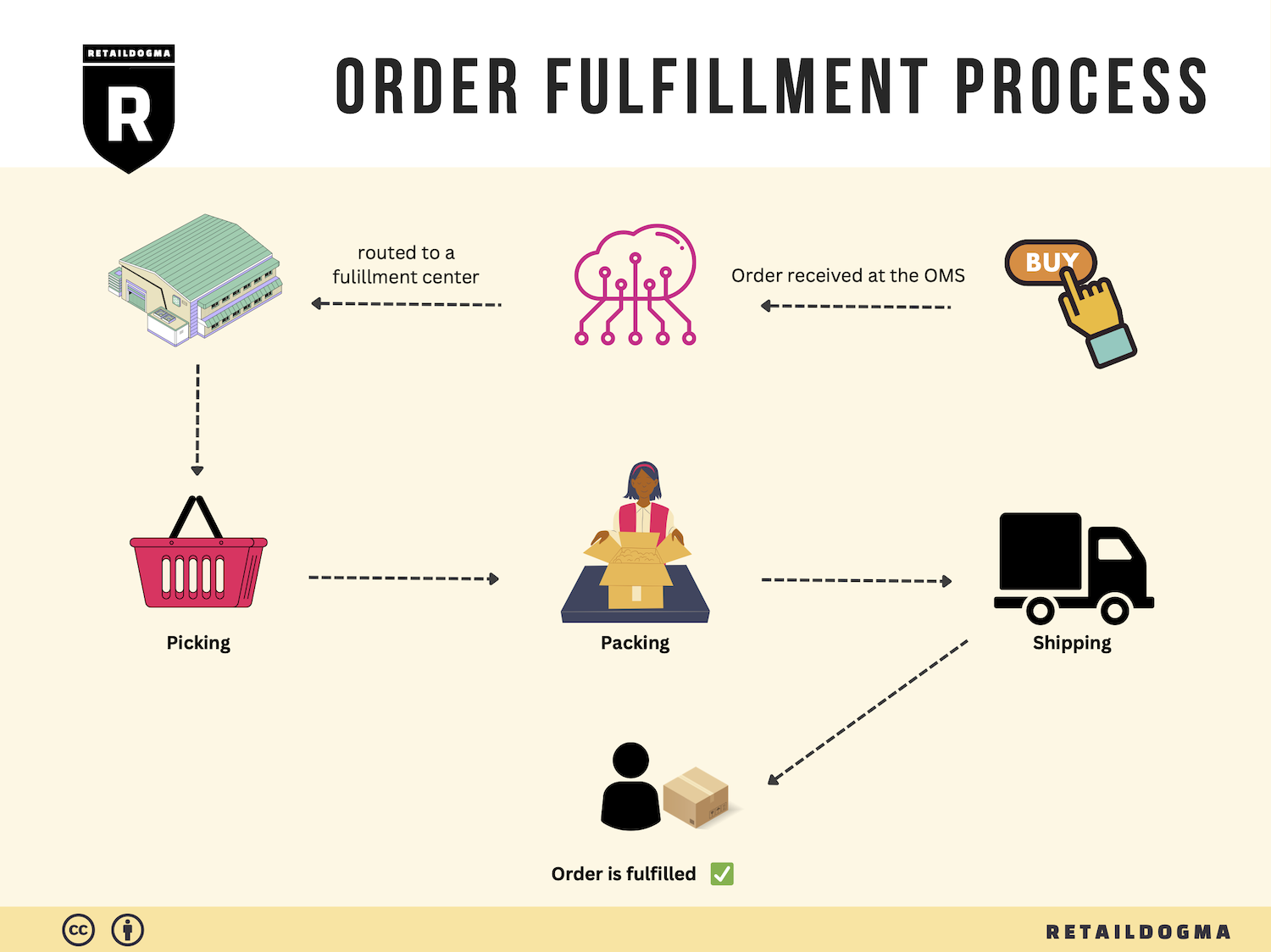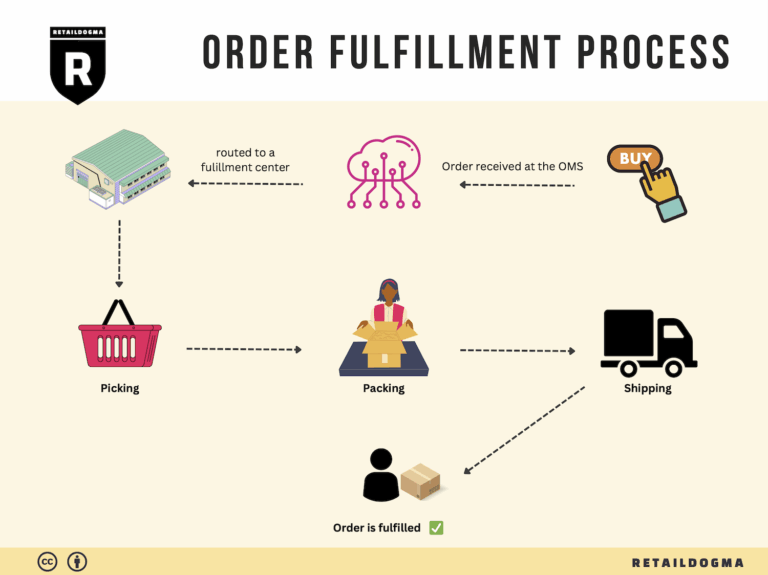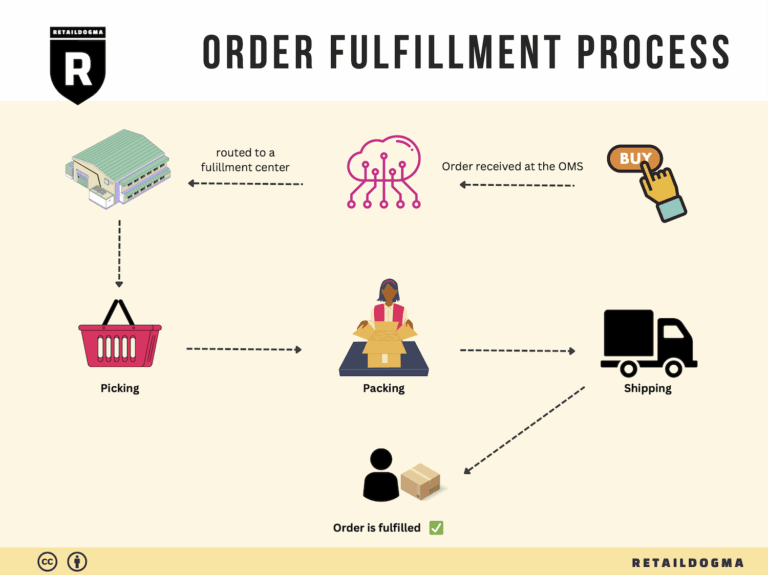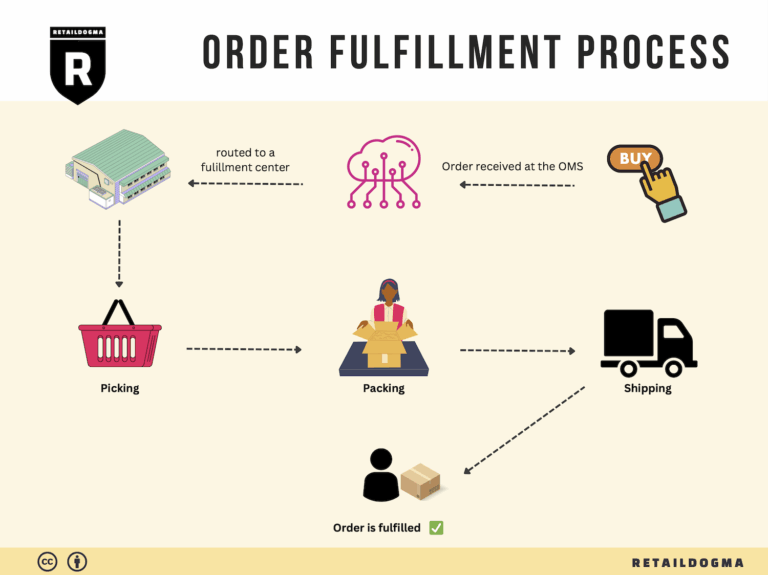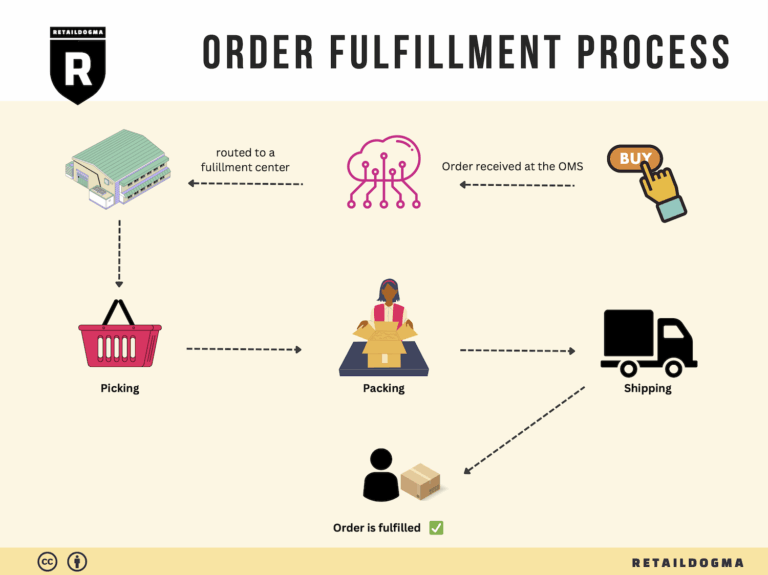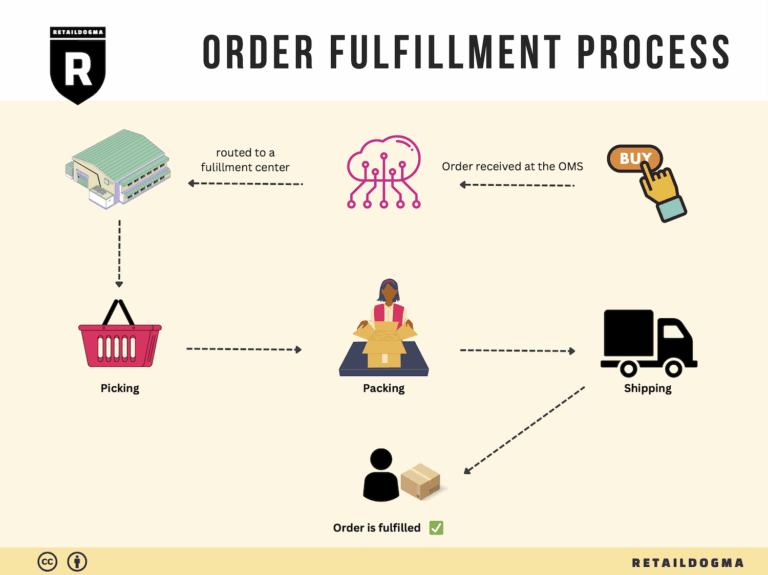What Is A Fulfillment Center? A Complete Guide (2025)
What is E-commerce Fulfillment? An Introduction for Growing Businesses
As your e-commerce business begins to scale, the thrill of increased sales can quickly be overshadowed by the daunting tasks of packing and shipping orders. Many entrepreneurs find themselves overwhelmed by these logistics, struggling to keep up with demand while ensuring timely deliveries and maintaining customer satisfaction. This is where e-commerce fulfillment becomes crucial. At its core, fulfillment is the process of getting a product from your warehouse or fulfillment center to your customer’s doorstep. However, the complexities of this process can vary significantly based on your business model and operational needs.
In this guide, we will delve into the various fulfillment models available to growing businesses, including Third-Party Logistics (3PL) and Fulfillment by Amazon (FBA). Each model has its unique advantages, and understanding these can help you make informed decisions about which path to pursue as you scale. We will explore the core services offered by fulfillment partners, such as inventory management, order processing, packing, and shipping.
Choosing the right fulfillment partner is critical for your business’s success. We’ll provide a framework for evaluating potential partners based on criteria such as location, technology integration, service offerings, and customer support. Pricing is another essential factor; we will break down the costs associated with different fulfillment options and help you understand how to calculate total fulfillment expenses to ensure you stay within budget.
The ultimate goal of this guide is to empower you to make smart, strategic decisions about your logistics. By understanding the landscape of e-commerce fulfillment, you can streamline your operations, enhance customer satisfaction, and focus on what you do best: growing your business. With the right knowledge and partner in place, fulfillment can transform from a burden into a seamless component of your e-commerce strategy, allowing you to scale efficiently and effectively.
What You’ll Learn In This Guide
- What is E-commerce Fulfillment? An Introduction for Growing Businesses
- The Order Fulfillment Process: From ‘Buy’ Button to Customer’s Door
- Comparing Fulfillment Models: In-House vs. 3PL vs. Dropshipping
- A Deep Dive into Amazon FBA: Pros, Cons, and Who It’s For
- Core Services Offered by Fulfillment Centers
- How to Choose a Fulfillment Partner: A 6-Point Checklist
- Understanding Fulfillment Pricing: A Breakdown of Common Fees
- Frequently Asked Questions (FAQs) about Fulfillment
- Conclusion: Is Outsourcing Fulfillment the Right Move for Your Business?
- Important Disclaimer
The Order Fulfillment Process: From ‘Buy’ Button to Customer’s Door
1. Receiving Inventory
The first step in the order fulfillment process is receiving inventory. When products arrive at the fulfillment center, they are checked against the purchase orders to ensure accuracy. This process involves inspecting the shipments for damages, verifying quantities, and recording the items into the inventory management system. Key terms associated with this step include SKU (Stock Keeping Unit), which helps in tracking individual items and their quantities.
This step is crucial because it establishes the foundation for efficient inventory management. Accurate receiving ensures that the inventory levels are correctly updated, which minimizes errors in order fulfillment later on. A well-organized receiving process can significantly reduce lead times and enhance overall operational efficiency, allowing businesses to respond quickly to customer demands.
2. Warehouse Storage
Once inventory has been received and verified, the next step is warehouse storage. Products are systematically organized in the fulfillment center, often using shelving systems, bins, or pallets. The goal is to optimize space and facilitate easy access for order picking. An important concept in this phase is the use of location codes, which helps staff quickly locate products within the warehouse.
Effective storage management is vital for several reasons. First, it ensures that items are easy to find, which speeds up the picking process. Second, it helps maintain inventory accuracy, as products are stored in designated areas. This reduces the risk of stockouts and overstock situations, both of which can negatively impact sales and customer satisfaction.
3. Order Picking
After a customer places an order, the next step is order picking. This involves retrieving the ordered items from their storage locations based on a pick list, which details the specific products and quantities needed for each order. Efficient picking methods, such as batch picking or zone picking, can enhance productivity and accuracy.
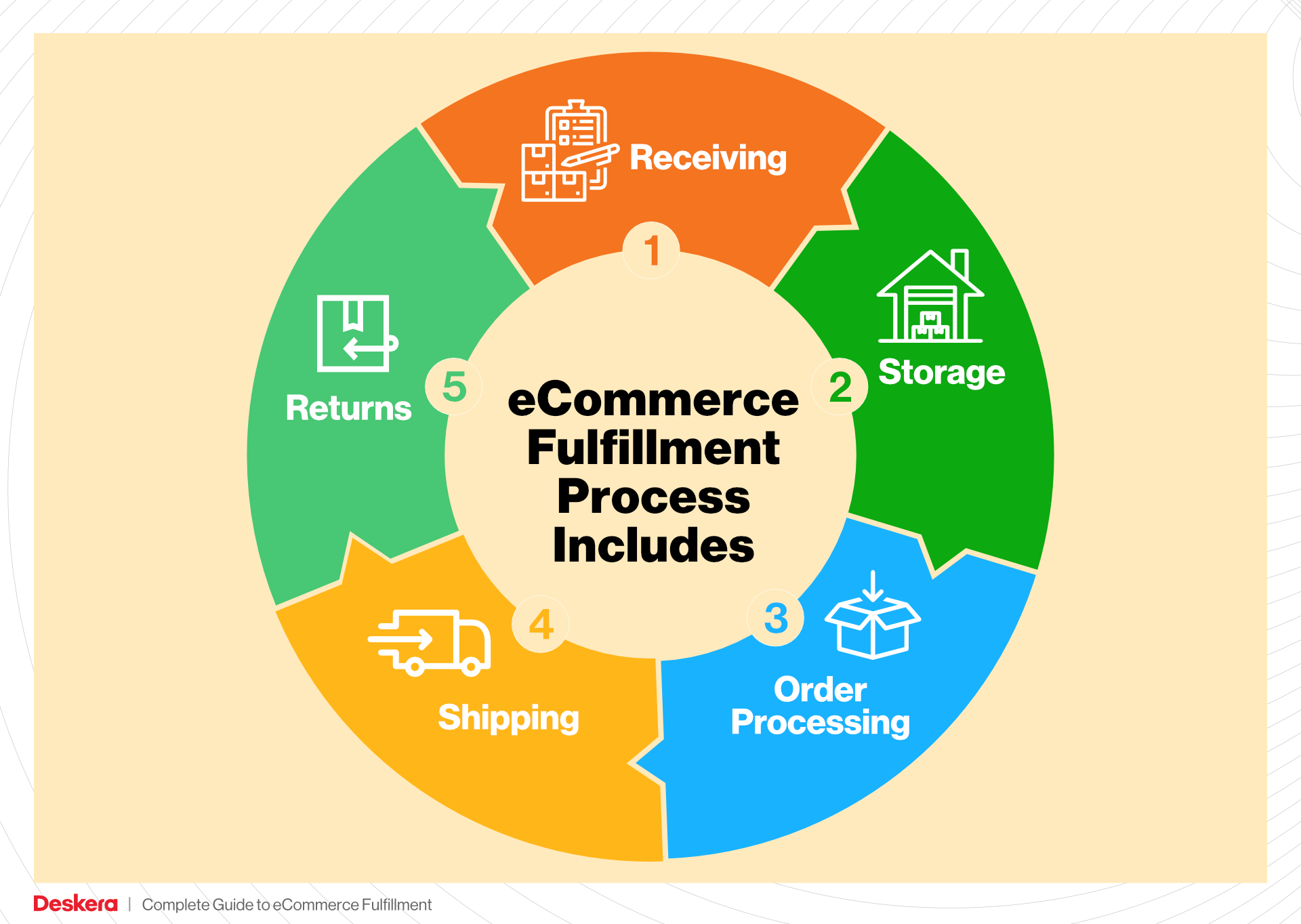
Order picking is a critical stage in the fulfillment process because it directly affects how quickly and accurately an order is fulfilled. Errors in this step can lead to customer dissatisfaction, returns, and increased operational costs. By implementing technology such as barcode scanners or automated picking systems, businesses can improve accuracy and efficiency in this phase, ensuring that customers receive the right products in a timely manner.
4. Order Packing
Once items have been picked, they move to the packing stage. Here, products are carefully packed into boxes, with attention given to cushioning and securing items to prevent damage during shipping. Packing slips, which include order details and return instructions, are typically included in the shipment. The concept of packaging optimization is vital in this step, as it ensures that the right materials are used to protect the items while minimizing shipping costs.
Packing is important for several reasons. First, it directly impacts the customer experience; well-packed items arrive in excellent condition, enhancing customer satisfaction. Second, it plays a role in cost management; efficient packing can reduce dimensional weight charges from carriers, leading to lower shipping expenses. Businesses that invest in quality packing processes can foster brand loyalty and encourage repeat purchases.
5. Shipping & Delivery
The final step in the order fulfillment process is shipping and delivery. Once packed, orders are labeled and prepared for shipment. This involves selecting the most efficient shipping method based on factors like cost, delivery speed, and customer preferences. Key terms associated with this step include shipping carriers and tracking numbers, which allow both the business and the customer to monitor the order’s journey.
Shipping and delivery are crucial for customer satisfaction, as they determine how quickly and reliably products arrive at the customer’s door. Delays or issues in this step can lead to negative experiences and harm a business’s reputation. By partnering with reliable carriers and implementing robust tracking systems, businesses can enhance transparency and build trust with their customers. Efficient shipping practices also contribute to overall operational efficiency, allowing businesses to scale effectively as they grow.
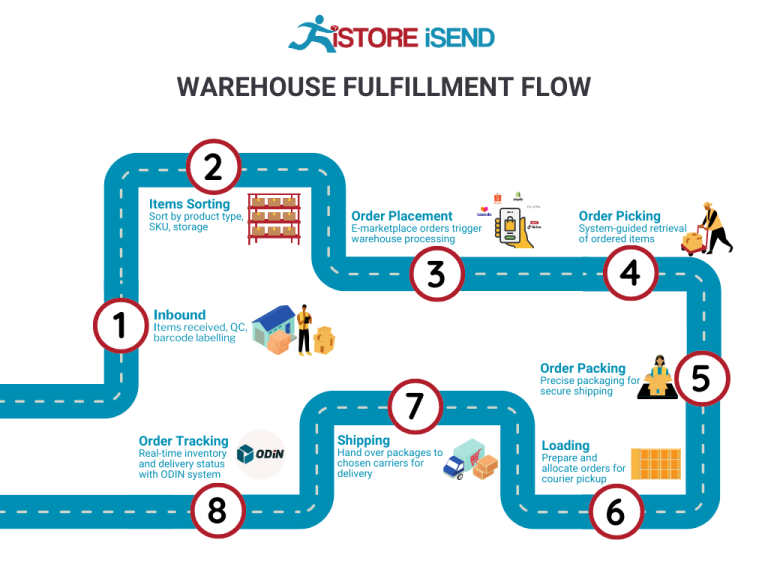
In summary, understanding and optimizing each step of the order fulfillment process—from receiving inventory to shipping and delivery—enables e-commerce businesses to improve efficiency, reduce costs, and enhance customer satisfaction. By focusing on these critical areas, businesses can position themselves for sustained growth and success in the competitive e-commerce landscape.
Comparing Fulfillment Models: In-House vs. 3PL vs. Dropshipping
Fulfillment Model Comparison
| Model | Who Handles Inventory | Best For (Business Stage) | Key Advantage | Key Disadvantage |
|---|---|---|---|---|
| In-House Fulfillment | The business itself | Established businesses with consistent sales | Full control over inventory and processes | High overhead costs and resource demands |
| Third-Party Logistics (3PL) | 3PL provider | Growing businesses looking to scale | Cost-effective and scalable solutions | Less control over inventory and logistics |
| Dropshipping | Supplier | Startups and small businesses | Low upfront costs and no inventory risk | Lower profit margins and less brand control |
In-House Fulfillment
In-house fulfillment involves managing the entire logistics process internally, where the business handles its own inventory, packing, and shipping. This model is often utilized by established businesses that have consistent sales and sufficient resources to maintain their own warehouse or fulfillment center. The key advantage of in-house fulfillment is the complete control it offers over inventory management and the fulfillment process. Businesses can tailor operations to their specific needs, ensuring quality control and a personalized customer experience. However, this model comes with significant disadvantages, primarily high overhead costs associated with staffing, warehousing, and logistics technology. Additionally, as order volumes increase, the strain on resources can lead to inefficiencies and operational challenges.
Third-Party Logistics (3PL)
Third-party logistics (3PL) providers offer a comprehensive solution for businesses looking to outsource their fulfillment needs. In this model, the 3PL handles everything from inventory storage to order processing and shipping. This option is particularly beneficial for growing businesses that need to scale their operations quickly without the burden of managing logistics themselves. A key advantage of using a 3PL is the cost-effectiveness and flexibility it provides, allowing businesses to adapt to changing demands without heavy investments in infrastructure. Additionally, 3PLs often have established relationships with shipping carriers, which can lead to lower shipping rates. However, the main drawback is the reduced control over inventory and logistics processes, which can impact brand experience if not managed properly. Businesses must select a reliable 3PL partner to mitigate risks associated with dependency on external providers.
Dropshipping
Dropshipping is a fulfillment model where the retailer does not hold inventory but instead transfers customer orders directly to a supplier, who then ships the product on behalf of the retailer. This model is particularly popular among startups and small businesses due to its low upfront costs and minimal financial risk. Retailers can offer a wide range of products without investing in inventory, making it an attractive option for those testing market viability. However, dropshipping comes with its own set of challenges, including lower profit margins as suppliers often charge higher wholesale prices. Additionally, retailers have less control over product quality and shipping times, which can lead to customer dissatisfaction. Building a strong relationship with reliable suppliers is crucial for success in this model, as it directly impacts the retailer’s brand reputation.
In conclusion, the choice of fulfillment model largely depends on the business stage, available resources, and strategic goals. Each model has its own set of advantages and disadvantages, and understanding these can help e-commerce business owners make informed decisions that align with their operational needs and growth objectives.
A Deep Dive into Amazon FBA: Pros, Cons, and Who It’s For
Understanding Fulfillment by Amazon (FBA)
Fulfillment by Amazon (FBA) is a service provided by Amazon that enables e-commerce businesses to store their products in Amazon’s fulfillment centers. Amazon then takes care of storage, packaging, shipping, and customer service, allowing sellers to focus on growing their business. This model has gained popularity among e-commerce entrepreneurs looking to leverage Amazon’s vast logistics network and customer base.
How FBA Works
-
Setup: To begin using FBA, sellers must create an Amazon seller account and register for the FBA service. Once registered, they can create product listings and prepare their inventory for shipment to Amazon’s fulfillment centers.
-
Shipping Inventory: Sellers send their products to Amazon’s warehouses. Amazon has multiple fulfillment centers across the globe, allowing for efficient distribution based on customer demand.
-
Storage and Management: Once the inventory arrives at Amazon, it is stored in their fulfillment centers. Amazon manages the inventory, tracking stock levels and product availability.
-
Order Fulfillment: When a customer places an order for a product listed under FBA, Amazon picks, packs, and ships the item directly to the customer. This process is designed to be fast and efficient, often resulting in same-day or next-day delivery for Prime members.
-
Customer Service: Amazon handles all customer inquiries and returns related to FBA products, providing a seamless experience for both sellers and buyers.
Pros of Using Amazon FBA
Prime Eligibility
One of the most significant advantages of FBA is that it qualifies sellers’ products for Amazon Prime. This means that Prime members, who represent a substantial portion of Amazon’s customer base, can access faster shipping options, leading to increased sales potential.
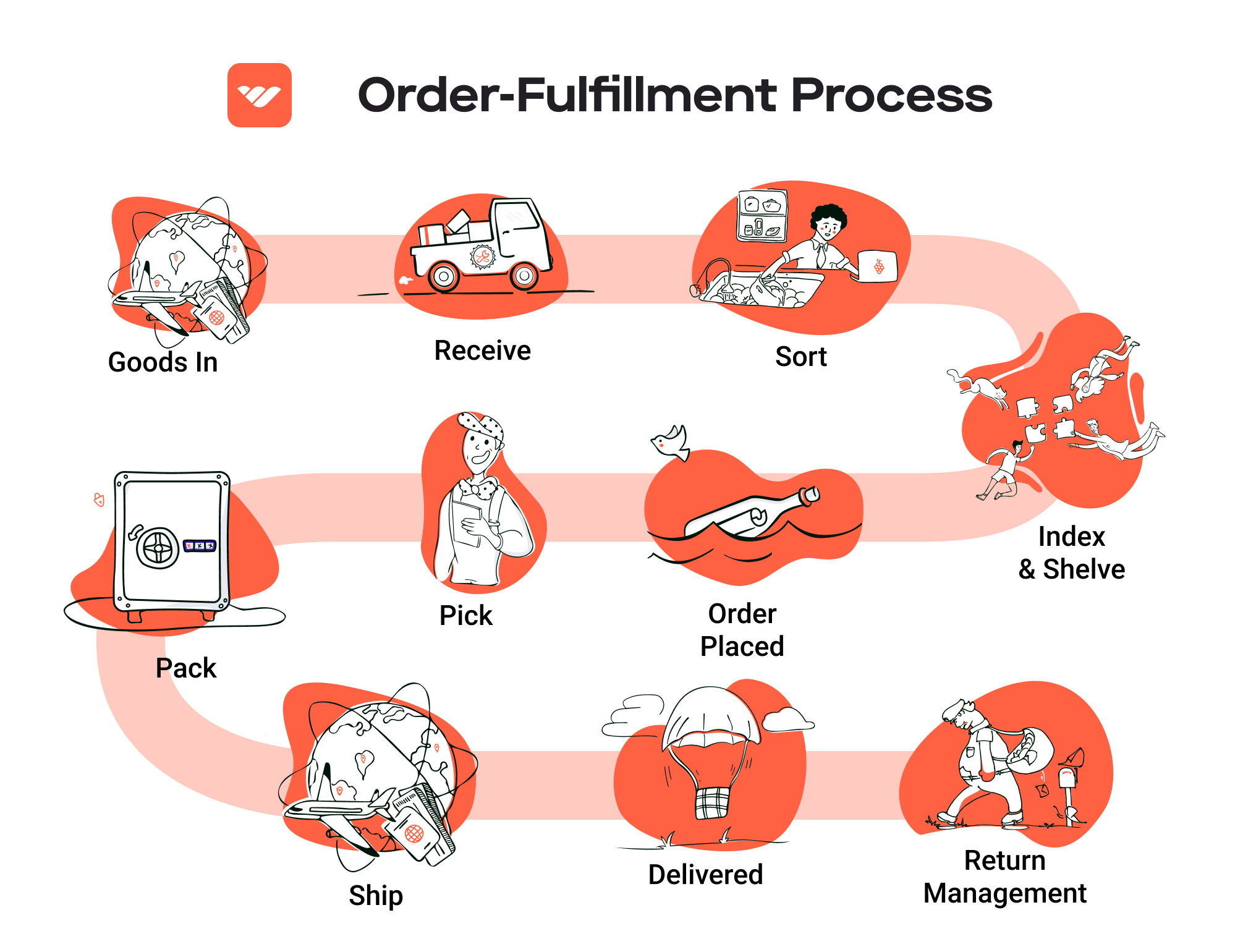
Customer Trust
Products fulfilled by Amazon benefit from the trust and credibility associated with the Amazon brand. Customers often feel more secure purchasing from sellers using FBA because they trust Amazon’s reputation for customer service and reliability.
Multi-Channel Fulfillment
FBA offers sellers the ability to fulfill orders from other sales channels, such as their own websites or other marketplaces, using Amazon’s infrastructure. This allows sellers to streamline their logistics and inventory management while maintaining a consistent customer experience.
Scalability
FBA is designed to help sellers scale their businesses efficiently. As demand increases, sellers can easily send more inventory to Amazon without the need for additional warehousing or fulfillment logistics on their part.
Simplified Logistics
By outsourcing fulfillment to Amazon, sellers can save time and resources on logistics management. Amazon’s advanced warehousing and distribution network can handle complex fulfillment processes, allowing sellers to focus on marketing and product development.
Cons of Using Amazon FBA
High Fees
While FBA can simplify logistics, it comes at a cost. Sellers are subject to various fees, including storage fees for their inventory and fulfillment fees based on the size and weight of the products. These costs can accumulate, particularly for sellers with low-margin products or high inventory turnover rates.
Strict Inventory Rules
Amazon has strict inventory management policies, including limits on the amount of inventory sellers can send to fulfillment centers. This can be particularly challenging for sellers with seasonal products or fluctuating demand, as they must carefully manage their stock levels to avoid penalties or restrictions.
Commingling Risks
FBA products are commingled, meaning that inventory from different sellers may be stored together in Amazon’s warehouses. This can pose risks, such as receiving returned products that do not belong to the original seller or having difficulty tracking inventory levels accurately.
Loss of Control
When utilizing FBA, sellers relinquish some control over the fulfillment process. This can lead to challenges in managing customer service and maintaining the brand’s unique voice, as Amazon handles all customer interactions.
Potential for Account Suspension
Sellers must adhere to Amazon’s guidelines and policies, which can be complex. Failure to comply can result in account suspensions, loss of selling privileges, or other penalties that can significantly impact a seller’s business.
Who is FBA Best For?
Fulfillment by Amazon is ideally suited for:
-
Small to Medium-Sized Sellers: Businesses that lack the infrastructure or resources to manage their logistics efficiently can benefit significantly from FBA’s streamlined operations.
-
Sellers with Established Products: Brands with products that have a proven track record and consistent sales can maximize the benefits of FBA, leveraging Amazon’s logistics network to scale quickly.
-
E-commerce Startups: New businesses looking to enter the e-commerce space can utilize FBA to simplify their logistics, allowing them to focus on marketing and product development without the burden of fulfillment management.
-
Brands Targeting Amazon Prime Customers: Sellers aiming to reach Amazon’s vast Prime customer base can capitalize on the increased visibility and sales potential that comes with FBA eligibility.
In conclusion, while Fulfillment by Amazon offers many advantages, including increased sales potential and simplified logistics, sellers must carefully weigh these benefits against the associated costs and challenges. Understanding these dynamics will empower e-commerce entrepreneurs to make informed decisions about their fulfillment strategies and ultimately drive their business growth.
Core Services Offered by Fulfillment Centers
Inventory Management & Warehousing
Inventory management is a fundamental service provided by fulfillment centers, encompassing the systematic control of stock levels, storage, and tracking of inventory. Fulfillment centers offer dedicated warehousing space that allows e-commerce businesses to store their products efficiently and securely. This service includes monitoring stock levels in real-time, which helps businesses avoid overstocking or running out of popular items.
Benefits:
1. Cost Efficiency: By utilizing a fulfillment center, e-commerce businesses can reduce costs associated with maintaining their own warehouse, such as rent, utilities, and staffing. This is particularly advantageous for small to medium-sized businesses that may not have the resources to manage a large inventory.
-
Scalability: As your business grows, a fulfillment center can easily accommodate increased inventory needs without the hassle of relocating or expanding your own facilities. This flexibility allows businesses to scale operations rapidly in response to market demand.
-
Improved Accuracy: Advanced inventory management systems utilized by fulfillment centers help minimize human error in tracking stock levels, ensuring that businesses always have an accurate view of their inventory. This leads to better decision-making regarding reordering and sales forecasting.
Pick and Pack Services
Pick and pack services are crucial in the order fulfillment process, where items are selected (picked) from the warehouse and prepared (packed) for shipment to customers. Upon receiving an order, fulfillment center staff efficiently gather the ordered items, package them securely, and label them for shipping, often using branded materials to maintain brand identity.
Benefits:
1. Efficiency: Fulfillment centers employ streamlined processes and technology to enhance picking and packing speed. This efficiency leads to faster order processing times, which is essential for meeting customer expectations in today’s fast-paced e-commerce environment.
-
Accuracy: Automated systems used in fulfillment centers help reduce the likelihood of errors in picking orders. This accuracy not only increases customer satisfaction but also minimizes the costs associated with returns and re-shipments due to incorrect orders.
-
Customization: Many fulfillment centers offer customizable packing options, allowing businesses to include promotional materials or personalized notes in their shipments. This added touch can enhance customer experience and foster brand loyalty.
Kitting and Assembly
Kitting and assembly services involve the grouping of individual items into a single packaged unit, or the assembly of components into a finished product. This service is particularly beneficial for e-commerce businesses that sell products requiring assembly or bundling, such as subscription boxes, gift sets, or promotional kits.
Benefits:
1. Time-Saving: By outsourcing kitting and assembly to a fulfillment center, e-commerce businesses can save time and focus on core activities like marketing and customer service. This is especially valuable for businesses with limited in-house labor.
-
Quality Control: Fulfillment centers often have dedicated teams that specialize in kitting and assembly, ensuring that products are assembled correctly and meet quality standards before shipping. This reduces the risk of customer dissatisfaction due to defective or improperly assembled products.
-
Inventory Optimization: Kitting allows businesses to manage inventory more effectively by combining multiple products into one SKU, simplifying inventory management and reducing the number of individual items tracked. This can lead to improved stock turnover rates and reduced holding costs.
Returns Management (Reverse Logistics)
Returns management, or reverse logistics, refers to the process of handling product returns from customers efficiently and effectively. Fulfillment centers provide comprehensive solutions for managing returns, including inspection, restocking, and processing refunds or exchanges.
Benefits:
1. Customer Satisfaction: A well-managed returns process is critical to maintaining customer trust and satisfaction. Fulfillment centers streamline this process, ensuring that returns are processed quickly and efficiently, which can lead to repeat business.
-
Data Insights: By analyzing return data, e-commerce businesses can gain valuable insights into customer behavior and product performance. Understanding why products are returned can help businesses improve product quality, adjust marketing strategies, and refine inventory management.
-
Cost Reduction: Efficient returns management helps minimize the costs associated with reverse logistics. Fulfillment centers can restock items quickly and efficiently, reducing the time and expense of handling returns and allowing businesses to recover lost revenue more effectively.
In summary, the core services offered by fulfillment centers play a vital role in enhancing the operational efficiency of e-commerce businesses. By leveraging inventory management, pick and pack services, kitting and assembly, and returns management, businesses can scale their operations, improve customer satisfaction, and ultimately drive growth in a competitive marketplace.
How to Choose a Fulfillment Partner: A 6-Point Checklist
Location & Warehouse Network
Importance: The geographical location of your fulfillment partner’s warehouses plays a crucial role in shipping speed and cost. A fulfillment center located closer to your customer base can significantly reduce delivery times and shipping expenses.
Questions to Ask:
1. Where are your fulfillment centers located, and how do they align with my target customer demographics?
2. What is your average shipping time to major regions in the country?
3. Do you have a network of warehouses that can support multi-channel distribution, including international shipping if needed?
Technology & Integrations
Importance: In today’s e-commerce landscape, having a robust technological foundation is vital for seamless order management, inventory tracking, and customer communication. Integration capabilities with your existing platforms (like Shopify, WooCommerce, etc.) can streamline operations and enhance efficiency.
Questions to Ask:
1. What technology do you use for inventory management and order fulfillment?
2. Can your system integrate with my e-commerce platform? If so, what is the process for integration?
3. How do you handle real-time inventory updates, and how frequently is data synchronized between our systems?
Specializations (e.g., Cold Storage, Oversized Items)
Importance: Depending on your product offerings, you may require specialized handling. For instance, if you sell perishable goods, a partner with cold storage capabilities is essential. Similarly, if your products are oversized or fragile, ensure the fulfillment center has the expertise to handle such items safely.
Questions to Ask:
1. What specializations do you offer that align with my product requirements?
2. How do you ensure the safety and integrity of specialized products during storage and shipping?
3. Can you provide case studies or references from other businesses with similar needs?
Scalability & Capacity
Importance: As your business grows, your fulfillment needs will evolve. A partner that can scale operations quickly is vital to accommodate increased order volumes without compromising service quality.
Questions to Ask:
1. What is your current capacity, and how do you handle peak seasons or sudden surges in demand?
2. Can you provide a clear plan for scaling operations in response to my business growth?
3. How do you manage inventory fluctuations, and what strategies do you have in place for high-demand periods?
Pricing and Contracts
Importance: Understanding the pricing structure and contract terms is crucial to avoid unexpected costs and ensure profitability. A transparent pricing model helps you plan your budget effectively.
Questions to Ask:
1. Can you break down your pricing structure, including storage fees, pick and pack fees, and shipping costs?
2. Are there any additional fees that I should be aware of, such as for returns or special handling?
3. What are the terms of the contract? Is there flexibility for renegotiation as my business grows?
Customer Support & Reviews
Importance: Reliable customer support can make or break your fulfillment experience. You need a partner who is responsive and proactive in addressing issues that may arise during the fulfillment process. Additionally, checking reviews can provide insights into their service quality and reliability.
Questions to Ask:
1. What customer support channels do you offer (e.g., phone, email, chat), and what are your response times?
2. Can you share testimonials or references from current clients regarding your customer service?
3. How do you handle fulfillment issues or customer complaints, and what is your escalation process?
By systematically evaluating potential fulfillment partners using this checklist, you can make an informed decision that supports your business’s growth and enhances customer satisfaction. Remember, the right partner will not only fulfill orders but also contribute to your overall operational efficiency and brand reputation.
Understanding Fulfillment Pricing: A Breakdown of Common Fees
Initial Setup Fees
Initial setup fees are one-time charges associated with onboarding your business with a fulfillment center. These fees can vary significantly based on the provider and the complexity of your operations. Typically, they cover the costs of integrating your systems with the fulfillment center’s technology, setting up inventory management systems, and establishing operational protocols.
The calculation of initial setup fees often depends on the following factors:
- Complexity of Integration: If your e-commerce platform requires custom API integrations or software development, costs will be higher.
- Volume of Products: A higher number of SKU (Stock Keeping Units) can lead to increased setup time and thus higher fees.
- Warehouse Configuration: If your products need special handling or specific storage arrangements, additional charges may apply.
Receiving Fees
Receiving fees are charged when the fulfillment center accepts your inventory. This fee covers the labor and equipment costs associated with unloading, inspecting, and storing your products.
Calculations for receiving fees typically consider:
- Quantity of Items: Many fulfillment centers charge based on the total number of units received. Higher volumes may lead to tiered pricing discounts.
- Condition of Products: If your products require special handling or inspection due to fragility or complexity, additional charges may be incurred.
- Receiving Time: If your inventory arrives during peak times, you might face additional surcharges due to increased labor costs.
Storage Fees (per pallet/bin)
Storage fees are ongoing charges for keeping your inventory in the fulfillment center. These fees can be assessed on a per pallet or per bin basis, depending on how your products are organized within the facility.
Key factors affecting storage fees include:
- Duration of Storage: Most fulfillment centers will charge monthly fees, which can vary based on how long your inventory is stored. Long-term storage (typically over 30 days) may incur additional charges.
- Space Utilization: Efficient use of space (e.g., stacking pallets) can reduce costs. If your inventory is bulky or requires special shelving, expect higher fees.
- Seasonal Variability: During peak seasons, such as holidays, storage fees may increase due to higher demand for space and resources.
Pick & Pack Fees (per item/order)
Pick and pack fees cover the labor and materials required to retrieve items from inventory and package them for shipment. This fee is typically charged on a per-item or per-order basis.
Factors influencing pick and pack fees include:
- Number of Items: The more items in an order, the higher the fees, as each item requires picking, packing, and labeling.
- Complexity of Packing: If your products require special packaging materials or techniques (e.g., fragile items), additional costs may apply.
- Order Frequency: High-volume orders may benefit from lower per-order fees due to economies of scale.
Shipping Fees
Shipping fees are among the most significant costs in fulfillment pricing, as they include the actual transportation of goods to customers. These fees can vary based on the shipping method chosen, destination, and the weight or dimensions of the package.
Shipping fee calculations often take into account:
- Shipping Method: Options may include standard, expedited, or same-day shipping, with costs reflecting speed and reliability.
- Destination: Shipping to remote or international locations generally incurs higher fees compared to local deliveries.
- Package Size and Weight: Heavier or oversized packages will typically cost more to ship.
Tips for Getting an Accurate Quote
To ensure you receive an accurate quote from a fulfillment center, consider the following tips:
- Be Transparent About Your Needs: Clearly communicate your expected order volume, product types, and any special handling requirements.
- Request Detailed Pricing Structures: Ask for a breakdown of all potential fees, including any variable costs that might arise during peak seasons.
- Consider Long-Term Costs: Evaluate how fees may change based on your business growth, especially in terms of storage and shipping.
- Negotiate Terms: Many fulfillment centers are open to negotiation, especially for high-volume clients. Don’t hesitate to discuss better rates or services.
- Get Multiple Quotes: Comparing quotes from several fulfillment centers can provide leverage in negotiations and help you find the best fit for your business.
By understanding these common fulfillment pricing models and following these tips, you can make informed decisions that align with your e-commerce business goals and help streamline your logistics operations.
Frequently Asked Questions (FAQs) about Fulfillment
1. What is the purpose of a fulfillment center?
A fulfillment center serves as a hub for managing inventory, processing orders, and shipping products directly to customers. It allows e-commerce businesses to outsource their logistics, ensuring timely and efficient delivery while they focus on growing their sales and customer relationships.
2. How does ATW Fulfillment Center operate?
ATW Fulfillment Center manages the entire order fulfillment process. After a customer places an order, the center picks the product from its inventory, packs it according to the seller’s specifications, and ships it directly to the customer. This streamlined process helps minimize errors and enhances customer satisfaction.
3. What is the difference between a warehouse and a fulfillment center?
While both warehouses and fulfillment centers store inventory, a warehouse primarily focuses on long-term storage of products, often for wholesale or bulk orders. In contrast, a fulfillment center is designed for efficient order processing and quick shipping, enhancing the customer experience by reducing delivery times.
4. What is a 3PL (Third-Party Logistics provider)?
A 3PL is a company that provides outsourced logistics services, including warehousing, inventory management, order fulfillment, and shipping. By partnering with a 3PL like ATW Fulfillment Center, e-commerce businesses can leverage specialized expertise and resources to optimize their supply chain and reduce operational costs.
5. How much do fulfillment services cost?
The cost of fulfillment services varies based on factors such as the volume of orders, the complexity of operations, storage requirements, and shipping destinations. ATW Fulfillment Center offers flexible pricing models tailored to meet the specific needs of your business, ensuring cost-effectiveness as you scale.
6. Can I customize packaging with ATW Fulfillment Center?
Yes, ATW Fulfillment Center allows businesses to customize packaging to reflect their brand identity. Your company name and branding will appear on all packages, ensuring that your customers receive a cohesive brand experience, even when the fulfillment is handled by a third party.
7. What types of products can be fulfilled through ATW Fulfillment Center?
ATW Fulfillment Center is equipped to handle a wide range of products, including security systems, personal emergency response devices, and more. If you have specific products in mind, it’s advisable to consult with the center to ensure they meet the necessary handling and shipping requirements.
8. How can I track my orders through ATW Fulfillment Center?
ATW Fulfillment Center provides order tracking capabilities, allowing you to monitor the status of shipments in real-time. You can access tracking information through their online portal, which helps you keep your customers informed about their order status and delivery times.
9. What are the benefits of using direct fulfillment services?
Direct fulfillment services, like those offered by ATW Fulfillment Center, allow businesses to streamline their inventory management, reduce overhead costs, and enhance customer satisfaction. By outsourcing fulfillment, you can focus on sales and marketing, while ensuring timely delivery and a professional customer experience.
10. How do I get started with ATW Fulfillment Center?
To get started with ATW Fulfillment Center, you can contact them directly through their website or by phone. They will guide you through the onboarding process, including setting up your account, integrating your e-commerce platform, and establishing fulfillment protocols tailored to your business needs.
Conclusion: Is Outsourcing Fulfillment the Right Move for Your Business?
Evaluating the Benefits of Outsourcing Fulfillment
In today’s competitive e-commerce landscape, outsourcing fulfillment can be a game-changer for businesses seeking efficiency and growth. By leveraging a fulfillment service, you can save valuable time and resources, allowing you to concentrate on core activities like marketing and product development. Fulfillment partners are equipped with the infrastructure and technology necessary to handle inventory management, order processing, and shipping logistics, thereby streamlining operations.
One of the most significant advantages of outsourcing is scalability. As your business grows, a reliable fulfillment center can seamlessly adapt to increased order volumes without the need for substantial investments in warehousing or staffing. This flexibility not only supports your immediate needs but also positions you for future growth, enabling you to scale operations quickly and efficiently.
Furthermore, partnering with a fulfillment expert provides access to specialized knowledge and best practices in logistics management. With their experience, fulfillment centers can optimize shipping routes, negotiate better shipping rates, and improve overall customer satisfaction through faster delivery times. This expertise can be instrumental in helping your business maintain a competitive edge in the market.
However, the key to maximizing these benefits lies in selecting the right fulfillment partner. A strategic partnership should align with your business goals and values, ensuring that you maintain brand integrity and customer satisfaction.
To determine if outsourcing fulfillment is the right move for your business, conduct a thorough audit of your current shipping processes. Evaluate your order volumes, delivery times, and customer feedback. This analysis will help you identify pain points and assess whether a fulfillment center can provide the solutions you need to support your growth journey. Take the step today to explore how outsourcing fulfillment could transform your operations and drive your business forward.
Important Disclaimer
⚠️ Important Disclaimer
The information in this guide is for educational purposes. Fulfillment services, pricing, and platform features change frequently. Always conduct your own due diligence and consult with providers directly before making business decisions.
